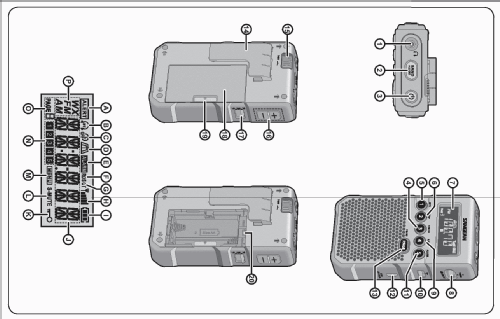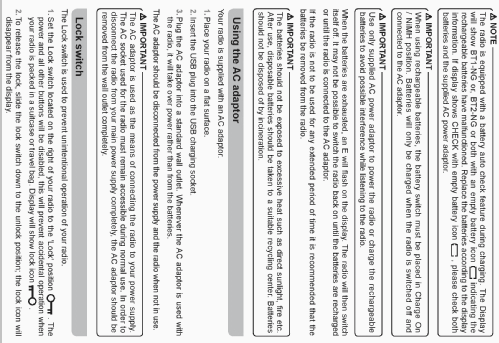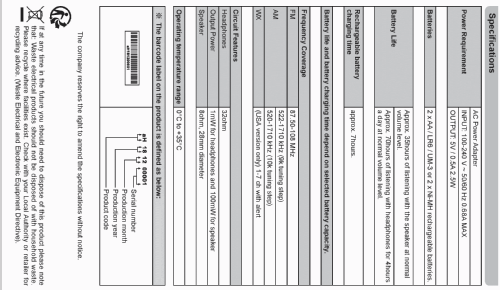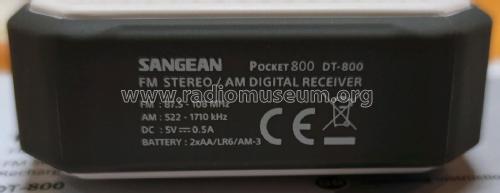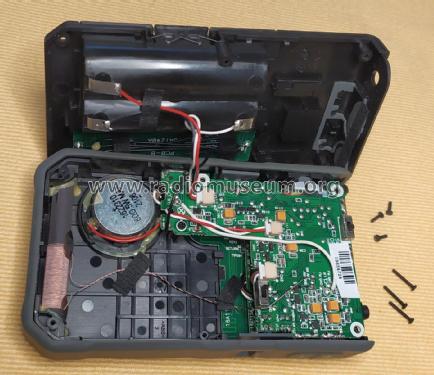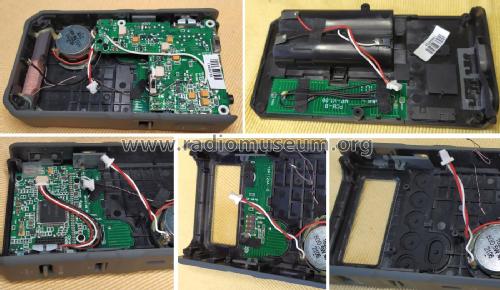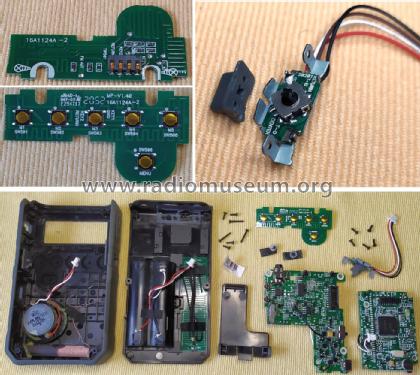Pocket 800 DT-800
Sangean; Chung Ho City
- Country
- Taiwan (Republic of China)
- Manufacturer / Brand
- Sangean; Chung Ho City
- Year
- 2018 ?
- Category
- Broadcast Receiver - or past WW2 Tuner
- Radiomuseum.org ID
- 333124
Click on the schematic thumbnail to request the schematic as a free document.
- Main principle
- DSP, Digital Signal Processor
- Wave bands
- Wave Bands given in the notes.
- Power type and voltage
- Batteries / addl. power jack / AA: 2 x 1.5 or AA: 2 x 1.2 Volt
- Loudspeaker
- Permanent Magnet Dynamic (PDyn) Loudspeaker (moving coil) / Ø 2.8 cm = 1.1 inch
- Power out
- 0.1 W (undistorted)
- Material
- Plastics (no bakelite or catalin)
- from Radiomuseum.org
- Model: Pocket 800 DT-800 - Sangean; Chung Ho City
- Shape
- Very small Portable or Pocket-Set (Handheld) < 8 inch.
- Dimensions (WHD)
- 68.2 x 115.4 x 26.5 mm / 2.7 x 4.5 x 1 inch
- Notes
-
The European model variant of the Sangean DT-800 shares a common design with the U.S. model (the AM/FM/WX DT-800) and with the domestic Chinese model (the DT-800C).
Despite the three model variants sharing a common set of features, each one has unique features suited to the target market.
Main specifications for the European model:
- Cabinet colors: Black and White
- Receiver bands:
- FM-RDS: Selectable between
- 87-108 MHz
- 76-108 MHz
- 64-108 MHz
- 76-90 MHz
- Tuning steps: 200 kHz, 100 kHz, 50 kHz, selectable
- Radio station name with RDS service
- AM: Selectable between
- 522-1710 kHz (9k tuning steps)
- 520-1710 kHz (10k tuning steps)
- FM-RDS: Selectable between
- 40 Memory Preset Stations (20 FM, 20 AM)
- Manual and Auto scan with ATS/APS
- Wide/Narrow Bandwith on AM and FM
- DSP Soft-Mute ON or OFF, selectable
- Clock with Alarm (Buzzer) and Sleep timer
- Auto clock sync with RDS CT service
- Dynamic Bass Boost
- Battery level indicator
- Lock switch
- Stereo Earphone socket (FM)
- Built-in Speaker
- Built-in Ni-MH battery charger (USB charger port)
- Can run on penlight AA batteries, or on Ni-MH rechargealble batteries, selectable at the back of the unit inside the battery compartment.
- Some production batches offer an AC Adapter able to deliver 5V 500mA
Please see additional model variants and technical details here: DT-800C
- Net weight (2.2 lb = 1 kg)
- 0.132 kg / 0 lb 4.7 oz (0.291 lb)
- Author
- Model page created by Jose Mesquita. See "Data change" for further contributors.
- Other Models
-
Here you find 77 models, 76 with images and 31 with schematics for wireless sets etc. In French: TSF for Télégraphie sans fil.
All listed radios etc. from Sangean; Chung Ho City
Collections
The model Pocket 800 is part of the collections of the following members.
Forum contributions about this model: Sangean; Chung Ho: Pocket 800 DT-800
Threads: 1 | Posts: 1
Among the owners complaints after buying this nice DT-800 pocket radio, is the alleged shorted life of the earphones jack.
After a few inserts and removals of the earphones plug, apparently something breaks at the earphones jack; some report the jack gets loose inside, rendering the earphones unusable.
Some report that Sangean had a few production batches with this issue, but later corrected.
My own unit was on sale in a "as used" condition from a well known Internet shop, described as having a few minor scratches and no accessories, user guide, or original box. I bought it as the price was almost half of current asking price for a "new in the box" unit.
The radio arrived in good working condition, but I noticed that when using earphones only one channel was working. I got the same result using another set of earphones.
So this unit was one more victim of the earphone jack failure. The s/n at the back says it was manufactured in 2021.
I didn't bother to return the unit, as I wanted to open it for analysis since I could not find technical details of this model. A draft with a block diagram with some observations was createed and uploaded here.
This is really a miniaturized, high density, packed radio, using no less than five double-sided PCB assemblies, three of them stacked together. One of them is a tiny PCB for the joystick encoder used to control up/down/select operations.
The printed circuit seems to be of good quality, The PCB copper traces are resistant to re-heat of a solder, and with good varnish coating. However the PCB isolation substrate is really thin, as expected for such a packed chassis.
I quickly verified that one audio channel terminal of the earphones jack was not connected to the output network of the audio amplifier (IC2 TDA2822G).
I had to use a magnifying lens under strong light to be able to see the cause. The five terminals of the jack are soldered to pads on the PCB. Two of them were loose from the PCB, as the copper pads broke away from the PCB substrate. After scratching the varnish coating to expose the copper traces, I was able to solder the terminals back to their original positions.
That fixed the issue for now.
How strong must the PCB copper pads be to resist minor sideways forces when inserting or removing the earphones plug?
Looking to the cabinet design, the hole where the jack is inserted looks tight enough to not allow for sideways jiggling that could result in PCB damage. Also the push and pull forces from the insert and removal of the earphones plug are 90 degrees away of the required force direction to cause the pads to unstick from the substrate.
This issue could more easily be caused by less careful back cover installation during the final production stage at the manufacturing plant. Some force needs to be applied to insert the back cover hole thru the jack while pushing down, and this leverage effect over the jack may have caused small fractures on the PCB pads and substrate glue. The radio would still pass the final quality test, but it will eventually fail to work if the pads finally got unstuck from the PCB substrate.
Jose Mesquita, 27.Oct.22

